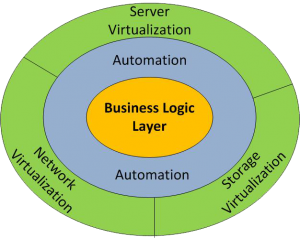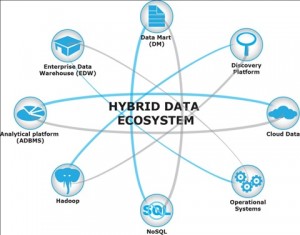After talking about the “grand vision” of the Software Defined Datacenter (SDD) in part 1 of this series and discussing the individual components required to build out the SDD in part 2, this third part will be all about the three core challenges and controversies:
Blades vs. Pizza Boxes
The miniaturized design of blade servers, as well as the chassis architecture, with its proprietary management software allows customers to maximize the number of physical servers per rack, while minimizing the power consumption per CPU. Blade server and chassis design, as well as the management software, are used by vendors as strategic differentiators. Therefore, building the SDD based on blade-infrastructure means abandoning the concept of using commodity hardware to facilitate cheap and flexible growth.
Most public clouds that are envied for their economies of scale, such as Amazon EC2, Windows Azure, and Google Cloud Platform are built upon a highly redundant setup of low-cost commodity hardware. Every time a certain number of clustered servers fail, the entire rack is replaced. Relying on commodity hardware makes the replacement of failed servers simple, keeps maintenance cost to a minimum, and avoids vendor lock-in. At the end of the day, the “blades vs. pizza” boxes discussion will have to be decided on a per-case basis, depending on the customer’s existing IT automation and management systems and on the desired type of cloud.
Intelligent Networking Hardware vs. Commodity Switches and Routers
Premium switch manufacturers such as Cisco Systems would argue that in a high density datacenter the core networking infrastructure that ultimately enables the SDN cannot be commoditized. Cisco maintains that high performance at scale requires sophisticated hardware and an integrated management layer to ensure service level compliance. While some of these arguments remind us of the reasons given by server manufacturers over a decade ago, regarding why server hardware will never be commoditized, EMA believes that Cisco owns tremendous intellectual property and should not be counted out just yet.
Open Architecture vs. vendor-specific Stacks
Selecting the best possible virtualization, automation, and orchestration stack as the foundation for the SDD is not a trivial task. Not only do customers have to weed through numerous offerings that are hard to compare (CloudStack, VMware vCloud, OpenStack, Eucalyptus, Nimbula, etc.), they also must make a much more profound decision regarding whether to select an open source or a proprietary platform. This decision can have extreme implications down the road, in terms of licensing cost, but also regarding support, integration, and technical capabilities.
None of these challenges are trivial and the ultimate outcome of all three controversies cannot be predicted at this point in time. What we do know is that organizations must ensure to select a strategy that fits their individual situation.
In the final part of this series, we will take a look at what organizations can do today to prepare for the Software Defined Datacenter.





